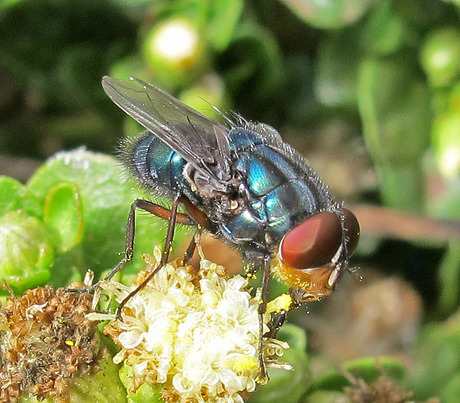Better late than never — Golden Goose Award goes to 'sex life of the screwworm' researchers

US researchers Edward F Knipling and Raymond C Bushland, who were ridiculed for their study of the sex life of the screwworm fly during the mid-20th century, will be posthumously honoured later this year with a Golden Goose Award.
The Golden Goose Award, created in 2012, honours scientists whose federally funded work may have been considered silly, odd or obscure when first conducted but has resulted in significant benefits to society. Knipling and Bushland are being cited for research that led to the ‘sterile insect technique’, in which lab-raised and sterilised male insects are used to overwhelm and eventually eradicate native pest populations.
Though most Americans today are not familiar with the screwworm fly, prior to the 1960s, ranchers in the southern US were locked in a constant struggle against the deadly insect. Female screwworms lay their eggs in the wounds of cattle, livestock and even humans. The eggs hatch into maggots that feed on wounded flesh; these maggots can kill a full size cow in less than two weeks. The pests cost ranchers hundreds of millions of dollars each year in lost livestock.
Working at field stations in Texas and Florida in the early 1930s to 1950s, Knipling, Bushland and their colleagues suggested the use of sterilised males to overwhelm wild screwworm flies and cause the population to collapse through natural mating behaviour — an approach that was met with scepticism from peers. The researchers went on to demonstrate that they could inflict mass sterilisation of insects through irradiation — a feat widely lauded as one of the most important developments in pest control and one of the first peaceful uses of nuclear radiation.
In 1953, after an unexpected request from a Dutch official on the island of Curacao, the researchers completed the first full-scale field test of the technique on the island. After just three months, not a single sterile egg could be found on the island. The technique worked even better than predicted.
The US Department of Agriculture (USDA), with support from state governments and local communities, launched a larger scale effort to eradicate the screwworm fly throughout the southern US. By 1982, the fly had been eradicated across the country. Since then, the USDA has partnered with countries throughout Central America to wipe out the flies to Panama, where today it maintains a border zone to prevent reinfestation from South America.
The eradication effort has saved US meat and dairy suppliers billions of dollars over the past 50-plus years and has also given US consumers an estimated 5% reduction in the price of supermarket beef. In the developing world, meanwhile, the pest control technique is a crucial component of food security and public health.
The technique continues to inform ongoing fights against other agricultural pests and insects carrying infectious pathogens, including the tsetse fly and the Aedes aegypti mosquito — the primary culprit in transmission of the Zika virus. It also serves as an inspiration for cutting-edge research on gene drives.
“Given the recent rise of infectious diseases like the Zika virus, developing eradication programs for carrier pests is a much-needed field of scientific research,” said US Representative Randy Hultgren. “Even though ‘worms’ might make some members of Congress — as well as the public — a little squeamish or sceptical of the research we invest in, these studies by Drs Edward F Knipling and Raymond C Bushland have clearly paid off.”
The entomological researchers will be honoured along with two other teams at the fifth annual Golden Goose Award Ceremony at the US Library of Congress on 22 September. For more information about the award, visit http://www.goldengooseaward.org/.
Melatonin helps to prevent obesity, studies suggest
In an experiment carried out in rats, chronic administration of melatonin prevented obesity to a...
Personality influences the expression of our genes
An international research team has used artificial intelligence to show that our personalities...
Pig hearts kept alive outside the body for 24 hours
A major hurdle for human heart transplantation is the limited storage time of the donor heart...







